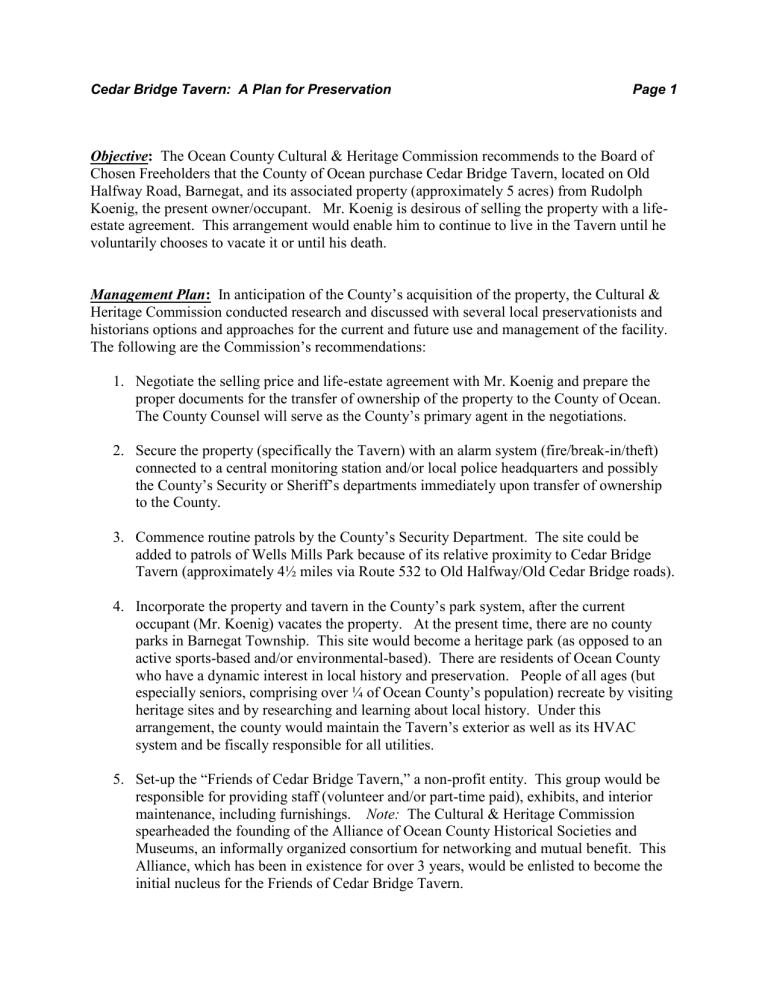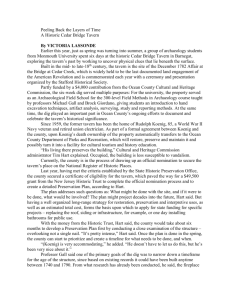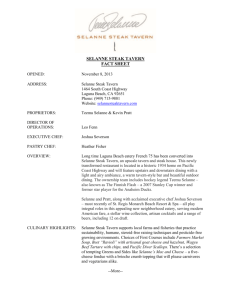A little more than a year ago, the Cultural & Heritage Commission

Cedar Bridge Tavern: A Plan for Preservation Page 1
Objective: The Ocean County Cultural & Heritage Commission recommends to the Board of
Chosen Freeholders that the County of Ocean purchase Cedar Bridge Tavern, located on Old
Halfway Road, Barnegat, and its associated property (approximately 5 acres) from Rudolph
Koenig, the present owner/occupant. Mr. Koenig is desirous of selling the property with a lifeestate agreement. This arrangement would enable him to continue to live in the Tavern until he voluntarily chooses to vacate it or until his death.
Management Plan:
In anticipation of the County’s acquisition of the property, the Cultural &
Heritage Commission conducted research and discussed with several local preservationists and historians options and approaches for the current and future use and management of the facility.
The following are the Commission’s recommendations:
1. Negotiate the selling price and life-estate agreement with Mr. Koenig and prepare the proper documents for the transfer of ownership of the property to the County of Ocean.
The County Counsel will serve as the County’s primary agent in the negotiations.
2.
Secure the property (specifically the Tavern) with an alarm system (fire/break-in/theft) connected to a central monitoring station and/or local police headquarters and possibly the County’s Security or Sheriff’s departments immediately upon transfer of ownership to the County.
3. Commence routine patrols by the County’s Security Department. The site could be
added to patrols of Wells Mills Park because of its relative proximity to Cedar Bridge
Tavern (approximately 4½ miles via Route 532 to Old Halfway/Old Cedar Bridge roads).
4.
Incorporate the property and tavern in the County’s park system, after the current occupant (Mr. Koenig) vacates the property. At the present time, there are no county parks in Barnegat Township. This site would become a heritage park (as opposed to an active sports-based and/or environmental-based). There are residents of Ocean County who have a dynamic interest in local history and preservation. People of all ages (but especially seniors, comprising over ¼ of Ocean County’s population) recreate by visiting heritage sites and by researching and learning about local history. Under this arrangement, the county would maintain the Tavern’s exterior as well as its HVAC system and be fiscally responsible for all utilities.
5.
Set-up the “Friends of Cedar Bridge Tavern,” a non-profit entity. This group would be responsible for providing staff (volunteer and/or part-time paid), exhibits, and interior maintenance, including furnishings. Note: The Cultural & Heritage Commission spearheaded the founding of the Alliance of Ocean County Historical Societies and
Museums, an informally organized consortium for networking and mutual benefit. This
Alliance, which has been in existence for over 3 years, would be enlisted to become the initial nucleus for the Friends of Cedar Bridge Tavern.
Cedar Bridge Tavern: A Plan for Preservation Page 2
6. Seek future designation of the site as a portal to the Pinelands National Reserve and/or to
the Coastal Heritage Trail. To supplement this designation, consider constructing a
replicated period barn to serve as an environmental interpretive center. Note: The State
owns about 300 acres of the surrounding property, which it maintains as green space.
7.
Engage an on-premises caretaker or overseer after the current occupant no longer resides at the Tavern. A live-in presence will facilitate ongoing security.
8.
Designate Cedar Bridge Tavern as an historic place, which tells the story of [a] its purpose and operation as a colonial tavern; [b] the role it played in the American
Revolution, including the civil strife between local patriots and loyalists. Future programming could be very interesting and exciting. Cedar Bridge Tavern could serve as a Revolutionary War center for both Ocean County and the Pine Barrens. It could be a focal center for the study of South Jersey life during the colonial period and during the fledgling stages of one of the Nation’s original thirteen states (i.e. explaining the importance of the tavern during these periods and the links connecting the shore to West
Jersey and Philadelphia and what developed along those links and why so many of those links ceased to exist after the mid-nineteenth century). For example, among other events, the Battle of Cedar Bridge could become annual reenactment. The Alliance of Ocean
County Historical Societies and Museums, County Parks & Recreation Department, and
Cultural & Heritage Commission could be co-sponsors of the programming.
9.
Nominate Cedar Bridge Tavern for listing on the National and State Registers of Historic
Places. Such status enables a publicly-owned site to be eligible for funding under various federal and state grant programs.
Rationale: Cedar Bridge Tavern is a little-known 225-year old historic structure nestled among the pines on Old Halfway Road in the Township of Barnegat. It is situated in the extreme western area of the township, off Route 72, near the Burlington County line (not far from the site of the Clayton’s Log Cabin, which burned to the ground several years ago). The Tavern and surrounding property (approximately 5 acres) has been owned and occupied for about 45 years by the same person, who, now in his early eighties, is contemplating selling it with a life estate arrangement. Over the past four decades, he has retained the primary characteristics of the colonial-style building intact. Some alterations have been made, however, to modernize the
Tavern — a kitchen, bathroom, porch, and greenhouse. The building has been maintained in, what appears to be, excellent condition. The roof, siding, and floors have been replaced.
However, the owner has tried to sustain the building’s ambience, by replacing old materials with like materials.
The Tavern has been recognized since the 1930s as a unique vestige of Ocean County’s past.
For many years, until the emergence of railroads, it served as a rest stop for stagecoaches that traveled from Camden to the shore. While other colonial taverns have survived the ravages of time and human intrusion, what makes this building particularly unusual is its small bar located in the southeast corner of the bar room. The bar has been identified by at least one historic
Cedar Bridge Tavern: A Plan for Preservation Page 3 preservationist as nearly 200 years old. He estimates, from an inspection of the bar’s nails, that it was built between 1810-1814. This fact alone is particularly extraordinary since most tavern bars have rarely endured into the twentieth century, much less the twenty-first.
Besides being remarkably still intact, Cedar Bridge Tavern belongs entirely to the past as an obvious link with events of yesteryear. Its place in history is as the site of what was probably last skirmish of the Revolutionary War on December 27, 1782. On that date, the Burlington
County Militia met and exchanged heavy fire with the notorious loyalist and refugee John Bacon and his band of pine robbers. Although the militia was seemingly winning the battle, the tide turned when a group of locals, who were loyal to Bacon, arrived. Their diversion gave Bacon the opportunity to retreat into the safety of the Pine Barrens. Historians point out that this event is another instance of the civil war that was fought in southern Monmouth County (now Ocean
County) during the Revolutionary War when neighbors crossed swords more than once — some as loyalists faithful to the Crown and others as patriots seeking independence from the Crown.
While Cedar Bridge Tavern has been privately owned throughout its long existence, public interest emerged whenever someone wrote about the Tavern or the skirmish at Cedar Bridge, such as Rev. Henry Carlton Beck ( Courier-Post : 1934, Forgotten Towns of Southern New
Jersey : 1936, Star-Ledger : 1955 & 1965). Its historic and architectural significance was established (long before the National Register of Historic Places was created) through the
Historic American Buildings Survey, completed in 1938 (HABS-NJ-41). This survey includes an extensive narrative description with photographs and architectural drawings of the structure’s exterior and the interior of each room as well as the bar ( see website at http://memory.loc.gov/ammem/mdbquery.html
). Today, because of the present owner’s desire to sell the property, interest has been renewed through a series of newspaper articles.
The Tavern is one of the few buildings constructed during the Colonial Period that still stands in
Ocean County. While the County has structures built during the nineteenth century, very few remain from the eighteenth century.
Following a field trip to Cedar Bridge in May 2003, the Cultural & Heritage Commission expressed support for public acquisition of the Tavern for its local historic value, noting that the
County has a scarcity of colonial-period buildings. Acquisition of the Tavern presents a rare opportunity to preserve a significant remnant from Ocean County’s colonial past.
Report prepared for Freeholder John C. Bartlett, Jr.
By Cynthia H. Smith, Administrator, Cultural & Heritage Commission
June 1, 2004
Cedar Bridge Tavern
A Plan for Preservation
Prepared by
Cynthia H. Smith
Administrator
Cultural & Heritage Commission
June 1, 2004
Reflections of War
Sites where battles once raged now offer places to contemplate the past while enjoying a family day out.
These places are quiet now, pastoral even
— places where children play in green fields on gently rolling hills and families enjoy picnics.
But, if you close your eyes, you can almost hear the thunder of cannons. . . . You can see the smoke-choked air, and the soldiers running. . . .
We go there to reflect to ponder, and to be changed somehow by the history these places represent.
Michael Riley
Asbury Park Press
May 28, 2004






